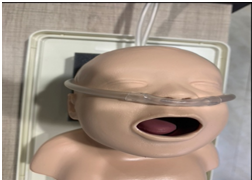
• The choice of interface affects the efficacy of NIPPV.
• The pressures as measured by the ventilators (before the interface) are dependent on interface resistance are not equivalent to what is delivered to the lung
Evaluation of a nasal cannula in noninvasive ventilation using a lung simulator. Iyer NP, Chatburn R.Respir Care. 2015 Apr;60(4):508-12.
Neonatal nasal intermittent positive pressure ventilation efficacy and lung pressure transmission. Mukerji A, Belik J.J Perinatol. 2015 Sep;35(9):716-9.
Tidal volume transmission during non-synchronized nasal intermittent positive pressure ventilation via RAM(®) cannula. Matlock DN, Bai S, Weisner MD, Comtois N, Beck J, Sinderby C, Courtney SE.J Perinatol. 2019 May;39(5):723-729
CODE:
13230A73 – FLOW CANNULA – XXS
13230B73 – FLOW CANNULA – XS
13230C73 – FLOW CANNULA – S
13230D73 – FLOW CANNULA – M
INDICATIONS FOR USE
The Flow Cannula is a product intended for use on premature and newborn babies that require supplemental oxygen, respiratory support or assistance in breathing in an outpatient, hospital or institutional setting.
It is used for the following therapies:
1. Heated and humidified high flow oxygen therapy
2. Non-invasive ventilation, with heated or no-heated, humidified flow
INSTRUCTIONS FOR USE
Select an appropriately sized cannula using the size guide provided in the package.
High Flow Oxygen Therapy:
Non Invasive Ventilation:
TECHNICAL CHARACTERISTICS
GENERAL INFORMATIONS
Cannula in TPE
Tube in medical PVC
Connector M15
Latex free
DEHP free
WARNINGS
• This device must be used only when the patient is under the continuous and direct supervision of the healthcare professional and frequent observation of the position of the cannula in the patient’s nostrils is necessary.
• Incorrect choice of size, improper placement or use can cause septal trauma or necrosis.
• The cannula tubes can represent a potential strangulation hazard.
• Always start the gas flow before inserting the cannula into the patient’s nostrils.
• Do not use if the package is damaged or opened.
• Do not immerse, wash or sterilize.
• Stop immediately if skin irritation occurs.
• For single patient use only.
• The device must be stored in a suitable, cool and dry place away from heat sources.
• Avoid exposure to direct light sources.
• The product, if it comes into contact with it, has chemical-physical incompatibilities with organic solvents (petrol, benzoyl, esters, ketones, chlorine hydrocarbon).
| PART NUMBER | SIZE | PRONGS LENGTH (mm) | OUTER DIAMETER(mm) |
| 13230A73 | XXS | 7,5 | 2,3 |
| 13230B73 | XS | 8,5 | 2,6 |
| 13230C73 | S | 9,5 | 3,0 |
| 13230D73 | M | 10,5 | 3,5 |